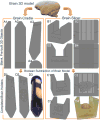Custom fit 3D-printed brain holders for comparison of histology with MRI in marmosets
- PMID: 26365332
- PMCID: PMC4662872
- DOI: 10.1016/j.jneumeth.2015.09.002
Custom fit 3D-printed brain holders for comparison of histology with MRI in marmosets
Abstract
Background: MRI has the advantage of sampling large areas of tissue and locating areas of interest in 3D space in both living and ex vivo systems, whereas histology has the ability to examine thin slices of ex vivo tissue with high detail and specificity. Although both are valuable tools, it is currently difficult to make high-precision comparisons between MRI and histology due to large differences inherent to the techniques. A method combining the advantages would be an asset to understanding the pathological correlates of MRI.
New method: 3D-printed brain holders were used to maintain marmoset brains in the same orientation during acquisition of ex vivo MRI and pathologic cutting of the tissue.
Results: The results of maintaining this same orientation show that sub-millimeter, discrete neuropathological features in marmoset brain consistently share size, shape, and location between histology and ex vivo MRI, which facilitates comparison with serial imaging acquired in vivo.
Comparison with existing methods: Existing methods use computational approaches sensitive to data input in order to warp histologic images to match large-scale features on MRI, but the new method requires no warping of images, due to a preregistration accomplished in the technique, and is insensitive to data formatting and artifacts in both MRI and histology.
Conclusions: The simple method of using 3D-printed brain holders to match brain orientation during pathologic sectioning and MRI acquisition enables rapid and precise comparison of small features seen on MRI to their underlying histology.
Keywords: 3D printing; EAE; Ex vivo; Histology; MRI; Marmoset.
Published by Elsevier B.V.
Figures







References
-
- Boretius S, Schmelting B, Watanabe T, Merkler D, Tammer R, Czéh B, et al. Fuchs E. Monitoring of EAE onset and progression in the common marmoset monkey by sequential high-resolution 3D MRI. NMR in Biomedicine. 2006;19(1):41–49. - PubMed
-
- Rausch M, Hiestand P, Baumann D, Cannet C, Rudin M. MRI-based monitoring of inflammation and tissue damage in acute and chronic relapsing EAE. Magnetic resonance in medicine. 2003;50(2):309–314. - PubMed
-
- ‘t Hart BA, Bauer J, Muller HJ, Melchers B, Nicolay K, Brok H, et al. Massacesi L. Histopathological characterization of magnetic resonance imaging-detectable brain white matter lesions in a primate model of multiple sclerosis: a correlative study in the experimental autoimmune encephalomyelitis model in common marmosets (Callithrix jacchus) The American journal of pathology. 1998;153(2):649–663. - PMC - PubMed
Publication types
MeSH terms
Substances
Grants and funding
LinkOut - more resources
Full Text Sources
Other Literature Sources
Medical

